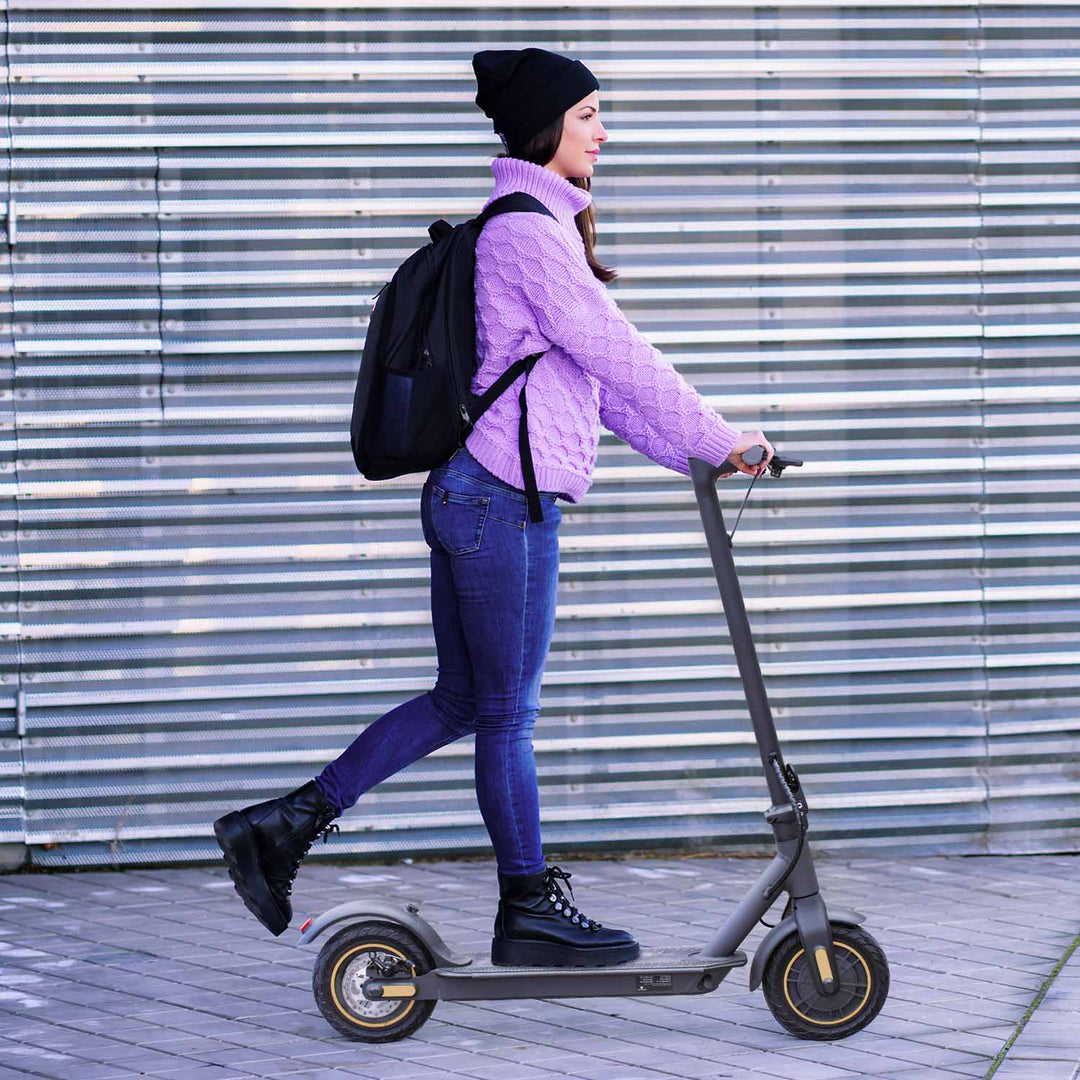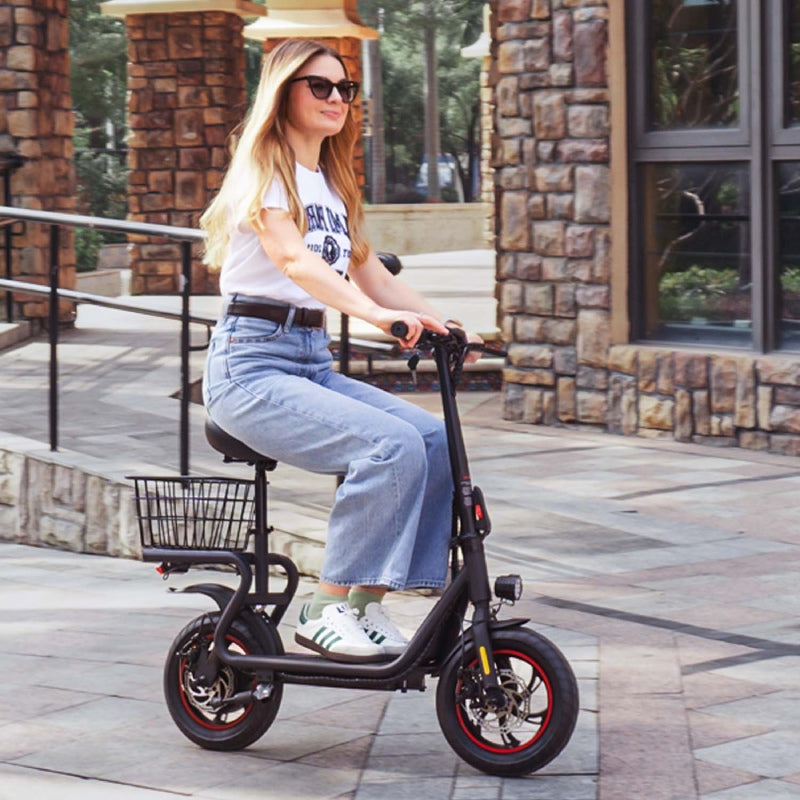How to Maintain and Riding an Electric Scooter in Winter ?
Table of Contents
1.Maintenance Tips for Your Electric Scooter
Proper maintenance is essential to ensure your electric scooter's optimal performance and longevity, especially during harsh winter conditions. Here's a detailed guide:1.1 Battery Care
-
Optimal Storage Temperature: Store your scooter in a cool, dry place with temperatures between 50°F (10°C) and 77°F (25°C) for optimal battery health.
-
Consistent Charging: Regularly charge your scooter to prevent deep discharges, which can significantly shorten battery life. Avoid full discharges, as they can damage lithium-ion batteries.
-
Avoid Extreme Temperatures: Extreme cold can reduce battery capacity and charging efficiency. If possible, warm your scooter slightly before charging in extremely cold conditions.
- Battery Health Indicators: Pay attention to your scooter's battery health indicators. If you notice signs of decreased performance or capacity, consult your scooter's manual or contact the manufacturer.
1.2 Tire Maintenance
-
Tire Pressure: Check tire pressure regularly and adjust as needed according to the manufacturer's recommendations. Slightly lower pressure can improve traction on slippery surfaces, but excessive deflation can compromise handling and stability.
-
Tire Condition: Inspect tires for wear, cracks, or punctures before each ride. Replace damaged tires promptly to prevent accidents.
- Tire Type: Consider using winter-specific tires with deeper tread patterns for improved grip on snow and ice.
1.3 Brake Maintenance
-
Brake Pad Inspection: Regularly inspect brake pads for wear and replace them if necessary. Worn brake pads can significantly reduce braking performance.
-
Brake Fluid (if applicable): Check brake fluid levels and condition, especially if your scooter has hydraulic brakes.
-
Brake Lever Adjustment: Ensure proper brake lever response by adjusting the brake lever if needed.
1.4 Overall Scooter Care
-
Thorough Cleaning: After each ride, clean your scooter with a mild detergent and water, paying close attention to the undercarriage, wheels, and electrical components.
-
Corrosion Prevention: Apply a thin layer of corrosion inhibitor to metal parts, especially after exposure to road salt.
-
Lubrication: Regularly lubricate moving parts like chains or cables to prevent squeaking and rust.
-
Fastener Tightening: Check all bolts and screws for tightness and tighten as needed to prevent loosening and damage.
- Storage: Store your scooter indoors in a dry place when not in use. Cover it with a protective cover if necessary.
2.Winter scooter riding: when it’s best and when it’s not
Winter can be a challenging season for electric scooter riders. While it's certainly possible to enjoy the convenience and fun of scooter commuting even in colder months, it's crucial to understand when and where it's safe to do so.2.1 When Winter Scooter Riding Is Suitable:
-
Short Commuting: If you live in a region with mild winters and well-maintained roads, using an electric scooter for short commutes on dry, sunny days can be a great way to beat traffic and stay active.
-
Closed Areas: Parks and private communities often have well-maintained paths that are less susceptible to ice and snow. These enclosed environments offer a safer riding experience during winter.
- Light Exercise: For those seeking a low-impact workout, electric scooters can be a fun and efficient way to get some exercise on milder winter days.
2.2 When to Avoid Winter Scooter Riding:
-
Severe Weather: Riding in heavy snow, ice, or fog is extremely dangerous. Slippery roads and reduced visibility can lead to accidents.
-
Long Distances: Cold temperatures can significantly decrease battery life. If you plan on long rides, make sure to have a backup plan or a portable charger.
-
Nighttime: Reduced visibility and potential hazards like black ice make nighttime riding particularly risky.
-
Poor Road Conditions: Potholes, uneven surfaces, and icy patches can compromise your stability and control.

3.Preparations Before Riding an Electric Scooter
Proper preparation is essential for safe and enjoyable winter scooter riding. Here's a detailed guide:3.1 Scooter Inspection and Maintenance
-
Tire Pressure: Slightly reduce tire pressure by 2-4 PSI for improved traction on slippery surfaces. However, avoid excessive deflation, as it can compromise handling and stability. Refer to your scooter's manual for specific recommendations.
-
Tire Condition: Inspect tires for wear, cracks, or punctures before each ride. Consider investing in winter tires with specialized tread patterns for enhanced grip on icy conditions.
-
Brake Function: Test brakes frequently to ensure optimal performance. Check brake pad thickness and brake fluid levels (if applicable).
-
Battery Health: Charge your scooter indoors to prevent battery damage from extreme cold. Be aware that battery life can be reduced by up to 30% in cold temperatures.
- Light Functionality: Verify that headlights, taillights, and turn signals are clean, functioning properly, and securely mounted. Consider using additional lights or reflectors for increased visibility.
3.2 Rider Preparation
-
Appropriate Attire: Wear multiple layers of warm, waterproof clothing, including a helmet, gloves, and insulated boots with good grip. Consider using hand warmers or heated grips for extra comfort.
-
Safety Gear: Invest in additional safety gear such as knee and elbow pads, especially for new or inexperienced riders.
- Visibility Enhancement: Wear brightly colored or reflective clothing and accessories. Consider using reflective tape on your scooter for added visibility.
3.3 Route Planning and Preparation
-
Road Conditions: Prioritize routes with well-maintained surfaces, avoiding areas prone to ice, heavy snow, or steep inclines.
-
Traffic Patterns: Choose less congested routes and times to minimize hazards.
-
Weather Forecast: Check weather forecasts before each ride to plan accordingly and avoid riding in extreme conditions.
- Emergency Preparedness: Carry a mobile phone, a basic repair kit, and emergency contact information.
4.Safe Riding Techniques for Electric Scooters
Winter conditions demand extra caution from electric scooter riders. Here are some key techniques with additional details and data to improve your safety:4.1 Dress for the Elements
-
Layering: Wear multiple layers (2-3) of moisture-wicking fabrics like merino wool or synthetic base layers to trap heat and keep dry.
-
Footwear: Opt for waterproof boots with a minimum tread depth of 6mm (0.24 inches) for optimal traction on slippery surfaces. Consider adding traction cleats for extra grip on ice.
-
Hand Protection: Wear insulated gloves with a waterproof outer shell to protect hands from windchill and moisture. Heated grips can provide additional comfort and dexterity (studies show a decrease in reaction time with cold hands).
- Head Protection: Always wear a helmet designed for cold weather with ear flaps and a visor. A properly fitted helmet should not move excessively when shaken.
4.2 Enhance Visibility (See and Be Seen)
-
Clothing: Wear brightly colored clothing or reflective vests with at least 3M™ Scotchlite™ reflective material. Reflective areas should cover a significant portion of your body (front, back, and sides).
-
Scooter Lights: Ensure your scooter's headlights (minimum 150 lumens) and taillights (minimum 50 lumens) are functioning properly and clean. Consider adding additional high-powered LED lights for better visibility, especially in low-light conditions.
- Daytime Running Lights: If available, use daytime running lights to improve your visibility during daylight hours, especially in foggy or hazy conditions.
4.3 Adapt Your Riding Style
-
Gradual Acceleration: Accelerate smoothly and progressively, especially from a standstill, to avoid wheel spin on slippery surfaces. Studies show a higher risk of accidents during the initial acceleration phase.
-
Gentle Braking: Apply brakes progressively with both hands to prevent wheel lock-up and maintain control. Remember, stopping distances will be significantly increased on slippery surfaces.
-
Increased Following Distance: Double or even triple your following distance compared to dry conditions to allow for longer stopping times.
-
Cornering with Caution: Reduce your speed significantly before entering a turn and lean into the turn gradually. Avoid sharp turns or sudden changes in direction.
-
Smooth Riding: Avoid jerky movements, sudden stops, or swerving. Maintain a smooth and controlled riding style on slippery surfaces.
-
Road Awareness: Constantly scan the road ahead for potential hazards like black ice, puddles, uneven surfaces, or debris. Black ice can be particularly dangerous as it's often invisible.
- Good Riding Habits: Always obey traffic laws, maintain a safe following distance, and signal turns clearly to communicate your intentions to other road users.
5.Post-Ride Maintenance for Electric Scooters
Post-ride maintenance is crucial for extending the lifespan of your electric scooter and ensuring safe operation throughout winter. Here's a detailed breakdown with specific parameters and techniques:5.1 Comprehensive Cleaning
-
Salt Removal: Salt (sodium chloride) is highly corrosive to metal components on your scooter. Use a mild detergent (pH balanced between 6 and 8) and a soft-bristled brush to thoroughly clean your scooter, paying particular attention to:
-
Undercarriage: Focus on areas like the battery compartment, motor, and suspension components.
-
Wheel Wells: Remove any accumulated dirt, debris, and salt buildup.
-
Brake Areas: Clean both disc brakes (if applicable) and drum brakes to remove grime that can affect performance.
-
Drying Time: After cleaning, allow your scooter to air dry completely for at least 24 hours before storage. Use microfiber cloths to absorb excess moisture and prevent water spots.
- Pro Tip: Consider using a dedicated bike degreaser to remove stubborn grime and salt from your scooter's drivetrain (if applicable).
5.2 Battery Care (Preserving Power)
-
Indoor Charging: Always charge your scooter indoors in a cool, dry place with temperatures between 50°F (10°C) and 77°F (25°C) to optimize battery health.
-
Storage: When not in use, store your scooter indoors in a cool, dry place with moderate humidity levels (ideally between 40% and 60%). Avoid storing your scooter in direct sunlight or extreme temperatures, as this can significantly reduce battery life.
- Data Point: Studies show that storing a lithium-ion battery at room temperature (around 70°F) can preserve up to 80% of its capacity after a year, compared to only 60% at freezing temperatures (32°F).
5.3 Tire Inspection (Maintaining Grip)
-
Tread Depth: Regularly check tire tread depth using a tire tread depth gauge. The minimum recommended tread depth for winter riding is typically 3/32 inch (2.4 mm) for optimal grip on slippery surfaces. Replace worn tires promptly.
-
Sidewall Damage: Inspect the sidewalls of your tires for any cuts, cracks, or bulges that could lead to a blowout. Damaged tires should be replaced immediately.
- Winter Tire Pressure: Adjust your tire pressure to the manufacturer's recommended level for winter conditions. This is usually slightly lower (2-4 PSI) than the pressure recommended for summer riding to improve traction on cold, wet surfaces.
5.4 Electrical Components (Preventing Moisture Issues)
-
Visual Inspection: Regularly examine all electrical connections for signs of corrosion or damage. Look for any loose wires, frayed cables, or discolored connectors.
-
Waterproofing: After cleaning your scooter, ensure that no water has seeped into electrical components like the motor controller or battery compartment. If you suspect water intrusion, consult a qualified scooter mechanic for inspection and potential repairs.
-
Removable Controller: If your scooter has a removable controller, store it indoors in a cool, dry place separate from the scooter to minimize the risk of moisture damage.
- Bonus Tip: Consider applying a silicone-based water repellent spray to electrical connectors after cleaning and drying your scooter for added protection against moisture.
With proper preparation, maintenance, and riding techniques, you can conquer winter and continue to enjoy the benefits of electric scooter transportation. So, bundle up, get ready to explore, and have a safe and fun winter riding season!
Learn More About:How Effective is the Exercise of Electric Scooters? Is it Better than Running?
Learn More About:What is the Min Age for Use Electric Scooter?
Learn More About:What is the Max Load Capacity of an Electric Scooter?













Leave a comment